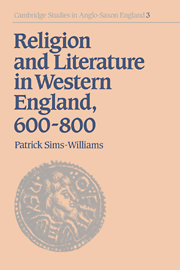Book contents
- Frontmatter
- Contents
- Preface
- List of abbreviations
- Map
- 1 Introduction
- 2 The kingdoms of the Hwicce and the Magonsætan
- 3 Paganism and Christianity
- 4 Early influences on the church
- 5 Varieties of monasticism
- 6 The eighth-century church
- 7 Biblical study
- 8 Letter-writing
- 9 The unseen world: the monk of Wenlock's vision
- 10 Prayer and magic
- 11 Milred, Cuthbert and Anglo-Latin poetry
- 12 The church in the landscape
- 13 Conclusion
- Bibliography
- Index
8 - Letter-writing
Published online by Cambridge University Press: 20 October 2009
- Frontmatter
- Contents
- Preface
- List of abbreviations
- Map
- 1 Introduction
- 2 The kingdoms of the Hwicce and the Magonsætan
- 3 Paganism and Christianity
- 4 Early influences on the church
- 5 Varieties of monasticism
- 6 The eighth-century church
- 7 Biblical study
- 8 Letter-writing
- 9 The unseen world: the monk of Wenlock's vision
- 10 Prayer and magic
- 11 Milred, Cuthbert and Anglo-Latin poetry
- 12 The church in the landscape
- 13 Conclusion
- Bibliography
- Index
Summary
Anglo-Saxons played a full part in continuing the ancient literary tradition of letter-writing and letter-collecting. Seventh- and eighth-century England already displays all the main medieval types of letter. There are purely practical communications, such as the letter of Wealdhere, bishop of London, to Archbishop Berhtwald in 704×705, and semi-public treatises in epistolary form, such as Bede's Epistola ad Ecgbertum. There are also numerous letters of friendship, congratulation, exhortation, encouragement, or condolence, notably in the collected correspondence of Aldhelm, Boniface and Lull. The originals of even practical letters stood little chance of being preserved, since they had no value as legal instruments, unlike charters. Indeed, a twelfth-century Canterbury archivist endorsed ‘Epistola inutilis’ on Wealdhere's letter, and it is a happy accident that it has survived; it is the oldest extant letter on vellum or parchment in Western Europe. Fortunately, however, letter-collections in book form were sometimes made, either because of the writers' importance or because of their letters' value as models of style. Education in letter-writing was clearly based on imitation. This is well conveyed by a letter which Boniface received soon after 732 from Leofgyth, a nun at Wimborne in Dorset. She concludes by asking Boniface to correct her rustic style and to send one of his own letters as a model (exempli gratia); she then adds four lines of halting verse (in formulae culled from Aldhelm), which she had
tried … to compose according to the rules of the poetic tradition, not trusting in my own boldness, but desiring to practise the first steps of a meagre and feeble talent, and wanting your help.
- Type
- Chapter
- Information
- Religion and Literature in Western England, 600–800 , pp. 211 - 242Publisher: Cambridge University PressPrint publication year: 1990

